Data
This shows an example with just 4 series of the M4 dataset. If you want to run it yourself on all of them, you can refer to this notebook.| unique_id | ds | y | |
|---|---|---|---|
| 86796 | H196 | 1 | 11.8 |
| 86797 | H196 | 2 | 11.4 |
| 86798 | H196 | 3 | 11.1 |
| 86799 | H196 | 4 | 10.8 |
| 86800 | H196 | 5 | 10.6 |
| … | … | … | … |
| 325235 | H413 | 1004 | 99.0 |
| 325236 | H413 | 1005 | 88.0 |
| 325237 | H413 | 1006 | 47.0 |
| 325238 | H413 | 1007 | 41.0 |
| 325239 | H413 | 1008 | 34.0 |
source
MLForecast
Forecasting pipeline
| Type | Default | Details | |
|---|---|---|---|
| models | Union | Models that will be trained and used to compute the forecasts. | |
| freq | Union | Pandas offset, pandas offset alias, e.g. ‘D’, ‘W-THU’ or integer denoting the frequency of the series. | |
| lags | Optional | None | Lags of the target to use as features. |
| lag_transforms | Optional | None | Mapping of target lags to their transformations. |
| date_features | Optional | None | Features computed from the dates. Can be pandas date attributes or functions that will take the dates as input. |
| num_threads | int | 1 | Number of threads to use when computing the features. |
| target_transforms | Optional | None | Transformations that will be applied to the target before computing the features and restored after the forecasting step. |
| lag_transforms_namer | Optional | None | Function that takes a transformation (either function or class), a lag and extra arguments and produces a name. |
source
MLForecast.fit
Apply the feature engineering and train the models.
| Type | Default | Details | |
|---|---|---|---|
| df | Union | Series data in long format. | |
| id_col | str | unique_id | Column that identifies each serie. |
| time_col | str | ds | Column that identifies each timestep, its values can be timestamps or integers. |
| target_col | str | y | Column that contains the target. |
| static_features | Optional | None | Names of the features that are static and will be repeated when forecasting. If None, will consider all columns (except id_col and time_col) as static. |
| dropna | bool | True | Drop rows with missing values produced by the transformations. |
| keep_last_n | Optional | None | Keep only these many records from each serie for the forecasting step. Can save time and memory if your features allow it. |
| max_horizon | Optional | None | Train this many models, where each model will predict a specific horizon. |
| prediction_intervals | Optional | None | Configuration to calibrate prediction intervals (Conformal Prediction). |
| fitted | bool | False | Save in-sample predictions. |
| as_numpy | bool | False | Cast features to numpy array. |
| weight_col | Optional | None | Column that contains the sample weights. |
| Returns | MLForecast | Forecast object with series values and trained models. |
| unique_id | ds | LGBMRegressor | |
|---|---|---|---|
| 0 | H196 | 961 | 16.079737 |
| 1 | H196 | 962 | 15.679737 |
| 2 | H196 | 963 | 15.279737 |
| 3 | H196 | 964 | 14.979737 |
| 4 | H196 | 965 | 14.679737 |
| 5 | H256 | 961 | 13.279737 |
| 6 | H256 | 962 | 12.679737 |
| 7 | H256 | 963 | 12.379737 |
| 8 | H256 | 964 | 12.079737 |
| 9 | H256 | 965 | 11.879737 |
| 10 | H381 | 961 | 56.939977 |
| 11 | H381 | 962 | 40.314608 |
| 12 | H381 | 963 | 33.859013 |
| 13 | H381 | 964 | 15.498139 |
| 14 | H381 | 965 | 25.722674 |
| 15 | H413 | 961 | 25.131194 |
| 16 | H413 | 962 | 19.177421 |
| 17 | H413 | 963 | 21.250829 |
| 18 | H413 | 964 | 18.743132 |
| 19 | H413 | 965 | 16.027263 |
| unique_id | ds | cutoff | y | LGBMRegressor | |
|---|---|---|---|---|---|
| 0 | H196 | 951 | 950 | 24.4 | 24.288850 |
| 1 | H196 | 952 | 950 | 24.3 | 24.188850 |
| 2 | H196 | 953 | 950 | 23.8 | 23.688850 |
| 3 | H196 | 954 | 950 | 22.8 | 22.688850 |
| 4 | H196 | 955 | 950 | 21.2 | 21.088850 |
| 5 | H256 | 951 | 950 | 19.5 | 19.688850 |
| 6 | H256 | 952 | 950 | 19.4 | 19.488850 |
| 7 | H256 | 953 | 950 | 18.9 | 19.088850 |
| 8 | H256 | 954 | 950 | 18.3 | 18.388850 |
| 9 | H256 | 955 | 950 | 17.0 | 17.088850 |
| 10 | H381 | 951 | 950 | 182.0 | 208.327270 |
| 11 | H381 | 952 | 950 | 222.0 | 247.768326 |
| 12 | H381 | 953 | 950 | 288.0 | 277.965997 |
| 13 | H381 | 954 | 950 | 264.0 | 321.532857 |
| 14 | H381 | 955 | 950 | 191.0 | 206.316903 |
| 15 | H413 | 951 | 950 | 77.0 | 60.972692 |
| 16 | H413 | 952 | 950 | 91.0 | 54.936494 |
| 17 | H413 | 953 | 950 | 76.0 | 73.949203 |
| 18 | H413 | 954 | 950 | 68.0 | 67.087417 |
| 19 | H413 | 955 | 950 | 68.0 | 75.896022 |
| 20 | H196 | 956 | 955 | 19.3 | 19.287891 |
| 21 | H196 | 957 | 955 | 18.2 | 18.187891 |
| 22 | H196 | 958 | 955 | 17.5 | 17.487891 |
| 23 | H196 | 959 | 955 | 16.9 | 16.887891 |
| 24 | H196 | 960 | 955 | 16.5 | 16.487891 |
| 25 | H256 | 956 | 955 | 15.5 | 15.687891 |
| 26 | H256 | 957 | 955 | 14.7 | 14.787891 |
| 27 | H256 | 958 | 955 | 14.1 | 14.287891 |
| 28 | H256 | 959 | 955 | 13.6 | 13.787891 |
| 29 | H256 | 960 | 955 | 13.2 | 13.387891 |
| 30 | H381 | 956 | 955 | 130.0 | 124.117828 |
| 31 | H381 | 957 | 955 | 113.0 | 119.180350 |
| 32 | H381 | 958 | 955 | 94.0 | 105.356552 |
| 33 | H381 | 959 | 955 | 192.0 | 127.095338 |
| 34 | H381 | 960 | 955 | 87.0 | 119.875754 |
| 35 | H413 | 956 | 955 | 59.0 | 67.993133 |
| 36 | H413 | 957 | 955 | 58.0 | 69.869815 |
| 37 | H413 | 958 | 955 | 53.0 | 34.717960 |
| 38 | H413 | 959 | 955 | 38.0 | 47.665581 |
| 39 | H413 | 960 | 955 | 46.0 | 45.940137 |
source
MLForecast.save
Save forecast object
| Type | Details | |
|---|---|---|
| path | Union | Directory where artifacts will be stored. |
| Returns | None |
source
MLForecast.load
Load forecast object
| Type | Details | |
|---|---|---|
| path | Union | Directory with saved artifacts. |
| Returns | MLForecast |
source
MLForecast.update
Update the values of the stored series.
| Type | Details | |
|---|---|---|
| df | Union | Dataframe with new observations. |
| Returns | None |
source
MLForecast.make_future_dataframe
Create a dataframe with all ids and future times in the forecasting horizon.
| Type | Details | |
|---|---|---|
| h | int | Number of periods to predict. |
| Returns | Union | DataFrame with expected ids and future times |
| unique_id | ds | |
|---|---|---|
| 0 | H196 | 961 |
| 1 | H256 | 961 |
| 2 | H381 | 961 |
| 3 | H413 | 961 |
source
MLForecast.get_missing_future
Get the missing id and time combinations in
X_df.
| Type | Details | |
|---|---|---|
| h | int | Number of periods to predict. |
| X_df | DFType | Dataframe with the future exogenous features. Should have the id column and the time column. |
| Returns | DFType | DataFrame with expected ids and future times missing in X_df |
source
MLForecast.forecast_fitted_values
Access in-sample predictions.
| Type | Default | Details | |
|---|---|---|---|
| level | Optional | None | Confidence levels between 0 and 100 for prediction intervals. |
| Returns | Union | Dataframe with predictions for the training set |
| unique_id | ds | y | LGBMRegressor | |
|---|---|---|---|---|
| 0 | H196 | 193 | 12.7 | 12.671271 |
| 1 | H196 | 194 | 12.3 | 12.271271 |
| 2 | H196 | 195 | 11.9 | 11.871271 |
| 3 | H196 | 196 | 11.7 | 11.671271 |
| 4 | H196 | 197 | 11.4 | 11.471271 |
| … | … | … | … | … |
| 3067 | H413 | 956 | 59.0 | 68.280574 |
| 3068 | H413 | 957 | 58.0 | 70.427570 |
| 3069 | H413 | 958 | 53.0 | 44.767965 |
| 3070 | H413 | 959 | 38.0 | 48.691257 |
| 3071 | H413 | 960 | 46.0 | 46.652238 |
| unique_id | ds | y | LGBMRegressor | LGBMRegressor-lo-90 | LGBMRegressor-hi-90 | |
|---|---|---|---|---|---|---|
| 0 | H196 | 193 | 12.7 | 12.671271 | 12.540634 | 12.801909 |
| 1 | H196 | 194 | 12.3 | 12.271271 | 12.140634 | 12.401909 |
| 2 | H196 | 195 | 11.9 | 11.871271 | 11.740634 | 12.001909 |
| 3 | H196 | 196 | 11.7 | 11.671271 | 11.540634 | 11.801909 |
| 4 | H196 | 197 | 11.4 | 11.471271 | 11.340634 | 11.601909 |
| … | … | … | … | … | … | … |
| 3067 | H413 | 956 | 59.0 | 68.280574 | 58.846640 | 77.714509 |
| 3068 | H413 | 957 | 58.0 | 70.427570 | 60.993636 | 79.861504 |
| 3069 | H413 | 958 | 53.0 | 44.767965 | 35.334031 | 54.201899 |
| 3070 | H413 | 959 | 38.0 | 48.691257 | 39.257323 | 58.125191 |
| 3071 | H413 | 960 | 46.0 | 46.652238 | 37.218304 | 56.086172 |
source
MLForecast.predict
Compute the predictions for the next
h steps.
| Type | Default | Details | |
|---|---|---|---|
| h | int | Number of periods to predict. | |
| before_predict_callback | Optional | None | Function to call on the features before computing the predictions. This function will take the input dataframe that will be passed to the model for predicting and should return a dataframe with the same structure. The series identifier is on the index. |
| after_predict_callback | Optional | None | Function to call on the predictions before updating the targets. This function will take a pandas Series with the predictions and should return another one with the same structure. The series identifier is on the index. |
| new_df | Optional | None | Series data of new observations for which forecasts are to be generated. This dataframe should have the same structure as the one used to fit the model, including any features and time series data. If new_df is not None, the method will generate forecasts for the new observations. |
| level | Optional | None | Confidence levels between 0 and 100 for prediction intervals. |
| X_df | Optional | None | Dataframe with the future exogenous features. Should have the id column and the time column. |
| ids | Optional | None | List with subset of ids seen during training for which the forecasts should be computed. |
| Returns | DFType | Predictions for each serie and timestep, with one column per model. |
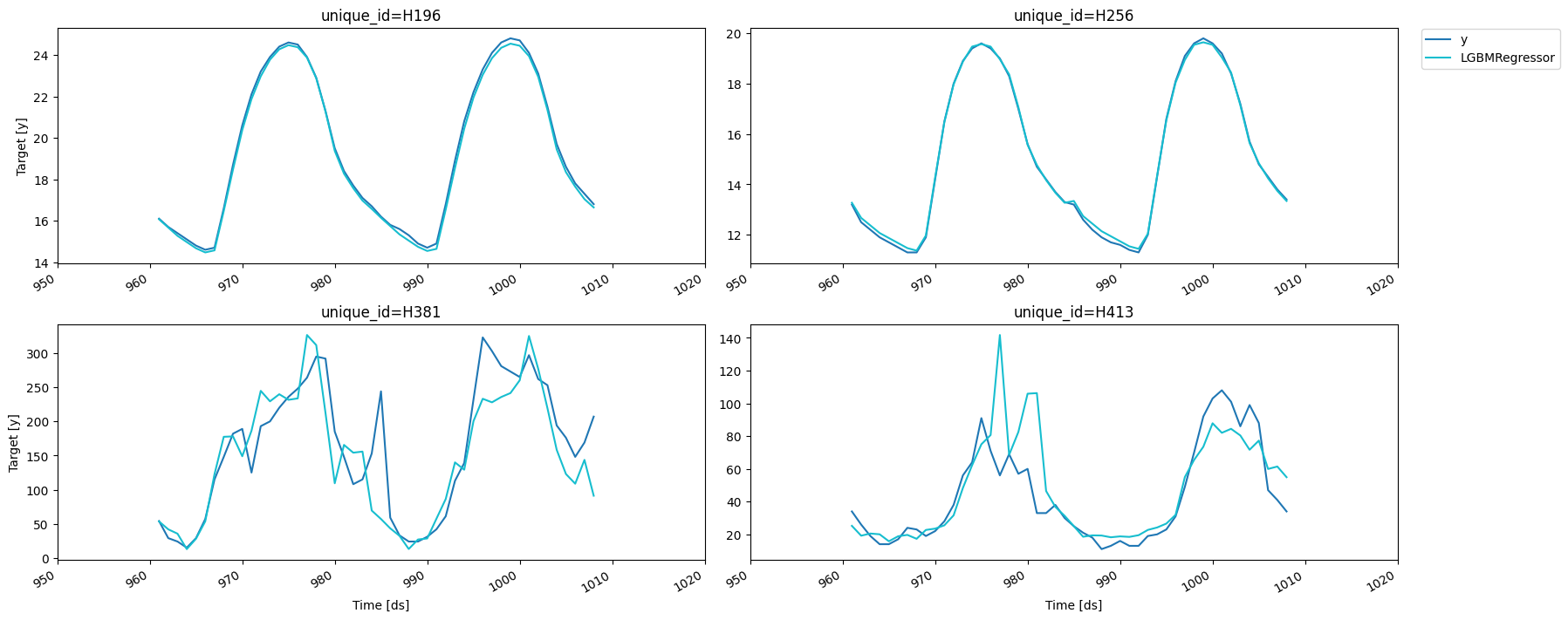
Prediction intervals
WithMLForecast,
you can generate prediction intervals using Conformal Prediction. To
configure Conformal Prediction, you need to pass an instance of the
PredictionIntervals
class to the prediction_intervals argument of the fit method. The
class takes three parameters: n_windows, h and method.
n_windowsrepresents the number of cross-validation windows used to calibrate the intervalshis the forecast horizonmethodcan beconformal_distributionorconformal_error;conformal_distribution(default) creates forecasts paths based on the cross-validation errors and calculate quantiles using those paths, on the other handconformal_errorcalculates the error quantiles to produce prediction intervals. The strategy will adjust the intervals for each horizon step, resulting in different widths for each step. Please note that a minimum of 2 cross-validation windows must be used.
predict method using the level argument. Levels must lie between
0 and 100.
| unique_id | ds | LGBMRegressor | LGBMRegressor-lo-95 | LGBMRegressor-lo-80 | LGBMRegressor-lo-50 | LGBMRegressor-hi-50 | LGBMRegressor-hi-80 | LGBMRegressor-hi-95 | |
|---|---|---|---|---|---|---|---|---|---|
| 0 | H196 | 961 | 16.071271 | 15.958042 | 15.971271 | 16.005091 | 16.137452 | 16.171271 | 16.184501 |
| 1 | H196 | 962 | 15.671271 | 15.553632 | 15.553632 | 15.578632 | 15.763911 | 15.788911 | 15.788911 |
| 2 | H196 | 963 | 15.271271 | 15.153632 | 15.153632 | 15.162452 | 15.380091 | 15.388911 | 15.388911 |
| 3 | H196 | 964 | 14.971271 | 14.858042 | 14.871271 | 14.905091 | 15.037452 | 15.071271 | 15.084501 |
| 4 | H196 | 965 | 14.671271 | 14.553632 | 14.553632 | 14.562452 | 14.780091 | 14.788911 | 14.788911 |
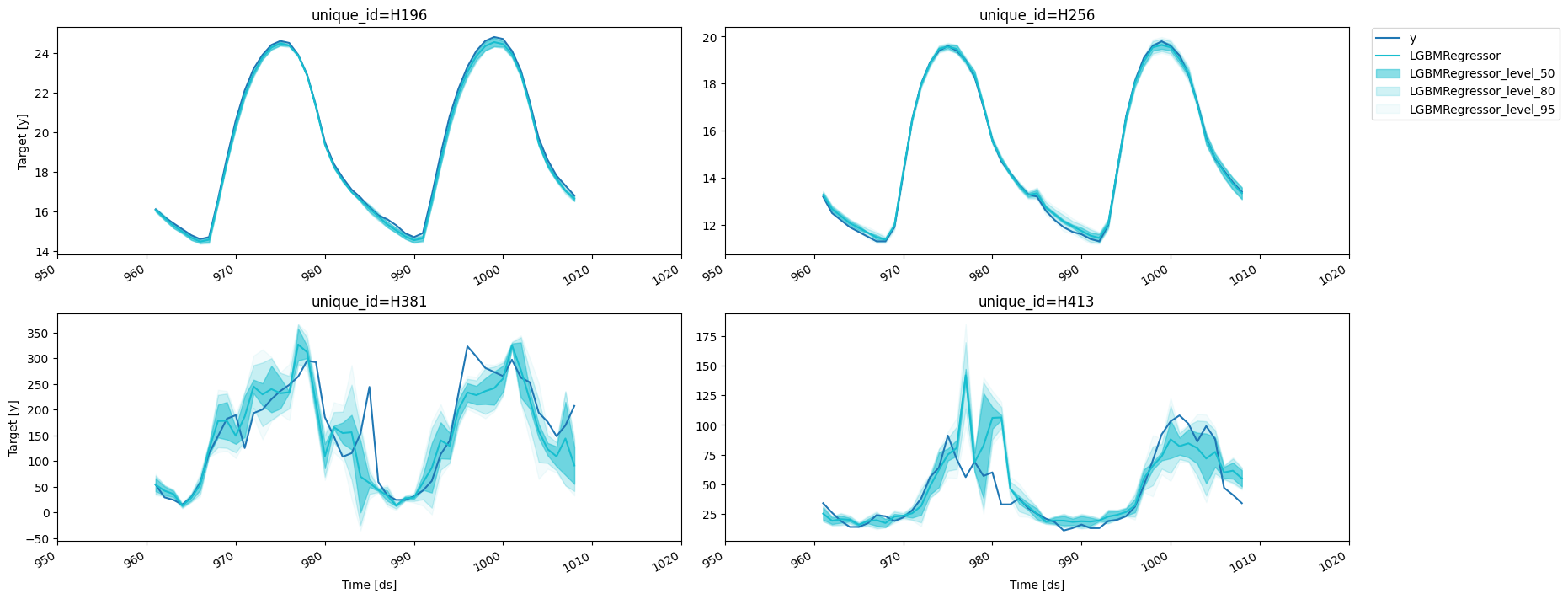
h=1 to the
PredictionIntervals
class. The caveat of this strategy is that in some cases, variance of
the absolute residuals maybe be small (even zero), so the intervals may
be too narrow.
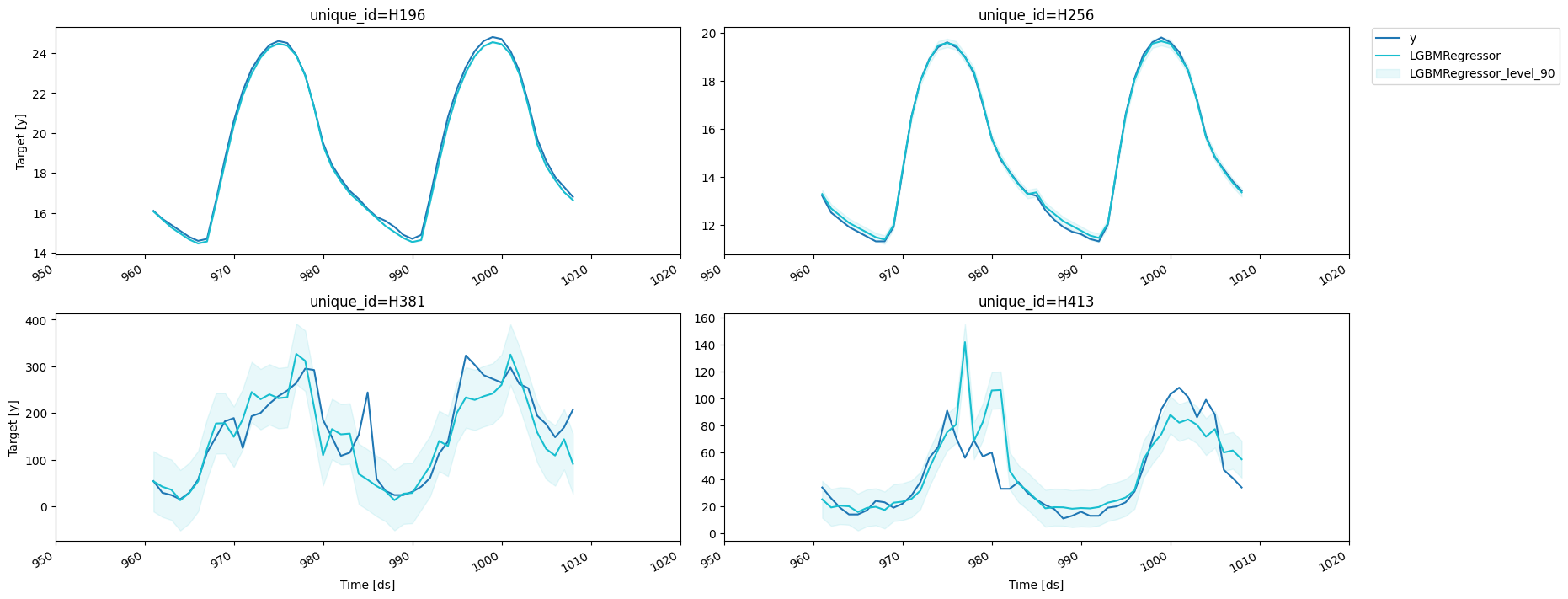
Forecast using a pretrained model
MLForecast allows you to use a pretrained model to generate forecasts for a new dataset. Simply provide a pandas dataframe containing the new observations as the value for thenew_df argument when calling the
predict method. The dataframe should have the same structure as the
one used to fit the model, including any features and time series data.
The function will then use the pretrained model to generate forecasts
for the new observations. This allows you to easily apply a pretrained
model to a new dataset and generate forecasts without the need to
retrain the model.

Forecast.preprocess.
source
MLForecast.preprocess
Add the features to
data.
| Type | Default | Details | |
|---|---|---|---|
| df | DFType | Series data in long format. | |
| id_col | str | unique_id | Column that identifies each serie. |
| time_col | str | ds | Column that identifies each timestep, its values can be timestamps or integers. |
| target_col | str | y | Column that contains the target. |
| static_features | Optional | None | Names of the features that are static and will be repeated when forecasting. |
| dropna | bool | True | Drop rows with missing values produced by the transformations. |
| keep_last_n | Optional | None | Keep only these many records from each serie for the forecasting step. Can save time and memory if your features allow it. |
| max_horizon | Optional | None | Train this many models, where each model will predict a specific horizon. |
| return_X_y | bool | False | Return a tuple with the features and the target. If False will return a single dataframe. |
| as_numpy | bool | False | Cast features to numpy array. Only works for return_X_y=True. |
| weight_col | Optional | None | Column that contains the sample weights. |
| Returns | Union | df plus added features and target(s). |
| unique_id | ds | y | lag24 | lag48 | lag72 | lag96 | lag120 | lag144 | lag168 | exponentially_weighted_mean_lag48_alpha0.3 | |
|---|---|---|---|---|---|---|---|---|---|---|---|
| 86988 | H196 | 193 | 0.1 | 0.0 | 0.0 | 0.0 | 0.3 | 0.1 | 0.1 | 0.3 | 0.002810 |
| 86989 | H196 | 194 | 0.1 | -0.1 | 0.1 | 0.0 | 0.3 | 0.1 | 0.1 | 0.3 | 0.031967 |
| 86990 | H196 | 195 | 0.1 | -0.1 | 0.1 | 0.0 | 0.3 | 0.1 | 0.2 | 0.1 | 0.052377 |
| 86991 | H196 | 196 | 0.1 | 0.0 | 0.0 | 0.0 | 0.3 | 0.2 | 0.1 | 0.2 | 0.036664 |
| 86992 | H196 | 197 | 0.0 | 0.0 | 0.0 | 0.1 | 0.2 | 0.2 | 0.1 | 0.2 | 0.025665 |
| … | … | … | … | … | … | … | … | … | … | … | … |
| 325187 | H413 | 956 | 0.0 | 10.0 | 1.0 | 6.0 | -53.0 | 44.0 | -21.0 | 21.0 | 7.963225 |
| 325188 | H413 | 957 | 9.0 | 10.0 | 10.0 | -7.0 | -46.0 | 27.0 | -19.0 | 24.0 | 8.574257 |
| 325189 | H413 | 958 | 16.0 | 8.0 | 5.0 | -9.0 | -36.0 | 32.0 | -13.0 | 8.0 | 7.501980 |
| 325190 | H413 | 959 | -3.0 | 17.0 | -7.0 | 2.0 | -31.0 | 22.0 | 5.0 | -2.0 | 3.151386 |
| 325191 | H413 | 960 | 15.0 | 11.0 | -6.0 | -5.0 | -17.0 | 22.0 | -18.0 | 10.0 | 0.405970 |
Forecast.fit_models, since this
only stores the series information.
source
MLForecast.fit_models
Manually train models. Use this if you called
MLForecast.preprocess
beforehand.
| Type | Details | |
|---|---|---|
| X | Union | Features. |
| y | ndarray | Target. |
| Returns | MLForecast | Forecast object with trained models. |
source
MLForecast.cross_validation
Perform time series cross validation. Creates
n_windows splits where
each window has h test periods, trains the models, computes the
predictions and merges the actuals.
| Type | Default | Details | |
|---|---|---|---|
| df | DFType | Series data in long format. | |
| n_windows | int | Number of windows to evaluate. | |
| h | int | Forecast horizon. | |
| id_col | str | unique_id | Column that identifies each serie. |
| time_col | str | ds | Column that identifies each timestep, its values can be timestamps or integers. |
| target_col | str | y | Column that contains the target. |
| step_size | Optional | None | Step size between each cross validation window. If None it will be equal to h. |
| static_features | Optional | None | Names of the features that are static and will be repeated when forecasting. |
| dropna | bool | True | Drop rows with missing values produced by the transformations. |
| keep_last_n | Optional | None | Keep only these many records from each serie for the forecasting step. Can save time and memory if your features allow it. |
| refit | Union | True | Retrain model for each cross validation window. If False, the models are trained at the beginning and then used to predict each window. If positive int, the models are retrained every refit windows. |
| max_horizon | Optional | None | |
| before_predict_callback | Optional | None | Function to call on the features before computing the predictions. This function will take the input dataframe that will be passed to the model for predicting and should return a dataframe with the same structure. The series identifier is on the index. |
| after_predict_callback | Optional | None | Function to call on the predictions before updating the targets. This function will take a pandas Series with the predictions and should return another one with the same structure. The series identifier is on the index. |
| prediction_intervals | Optional | None | Configuration to calibrate prediction intervals (Conformal Prediction). |
| level | Optional | None | Confidence levels between 0 and 100 for prediction intervals. |
| input_size | Optional | None | Maximum training samples per serie in each window. If None, will use an expanding window. |
| fitted | bool | False | Store the in-sample predictions. |
| as_numpy | bool | False | Cast features to numpy array. |
| weight_col | Optional | None | Column that contains the sample weights. |
| Returns | DFType | Predictions for each window with the series id, timestamp, last train date, target value and predictions from each model. |
MLForecast.cross_validation,
which takes our data and performs the process described above for
n_windows times where each window has h validation samples in it.
For example, if we have 100 samples and we want to perform 2 backtests
each of size 14, the splits will be as follows:
- Train: 1 to 72. Validation: 73 to 86.
- Train: 1 to 86. Validation: 87 to 100.
step_size argument. For example, if we have 100 samples and we want to
perform 2 backtests each of size 14 and move one step ahead in each fold
(step_size=1), the splits will be as follows:
- Train: 1 to 85. Validation: 86 to 99.
- Train: 1 to 86. Validation: 87 to 100.
refit=False. This allows you to evaluate the
performance of your models using multiple window sizes without having to
retrain them each time.
| unique_id | ds | cutoff | y | LGBMRegressor | |
|---|---|---|---|---|---|
| 0 | H196 | 865 | 864 | 15.5 | 15.373393 |
| 1 | H196 | 866 | 864 | 15.1 | 14.973393 |
| 2 | H196 | 867 | 864 | 14.8 | 14.673393 |
| 3 | H196 | 868 | 864 | 14.4 | 14.373393 |
| 4 | H196 | 869 | 864 | 14.2 | 14.073393 |
| … | … | … | … | … | … |
| 379 | H413 | 956 | 912 | 59.0 | 64.284167 |
| 380 | H413 | 957 | 912 | 58.0 | 64.830429 |
| 381 | H413 | 958 | 912 | 53.0 | 40.726851 |
| 382 | H413 | 959 | 912 | 38.0 | 42.739657 |
| 383 | H413 | 960 | 912 | 46.0 | 52.802769 |
fitted=True we can access the predictions for the
training sets as well with the cross_validation_fitted_values method.
| unique_id | ds | fold | y | LGBMRegressor | |
|---|---|---|---|---|---|
| 0 | H196 | 193 | 0 | 12.7 | 12.673393 |
| 1 | H196 | 194 | 0 | 12.3 | 12.273393 |
| 2 | H196 | 195 | 0 | 11.9 | 11.873393 |
| 3 | H196 | 196 | 0 | 11.7 | 11.673393 |
| 4 | H196 | 197 | 0 | 11.4 | 11.473393 |
| … | … | … | … | … | … |
| 5563 | H413 | 908 | 1 | 49.0 | 50.620196 |
| 5564 | H413 | 909 | 1 | 39.0 | 35.972331 |
| 5565 | H413 | 910 | 1 | 29.0 | 29.359678 |
| 5566 | H413 | 911 | 1 | 24.0 | 25.784563 |
| 5567 | H413 | 912 | 1 | 20.0 | 23.168413 |
prediction_intervals as well as values for the width through levels.
| unique_id | ds | cutoff | y | LGBMRegressor | LGBMRegressor-lo-90 | LGBMRegressor-lo-80 | LGBMRegressor-hi-80 | LGBMRegressor-hi-90 | |
|---|---|---|---|---|---|---|---|---|---|
| 0 | H196 | 865 | 864 | 15.5 | 15.373393 | 15.311379 | 15.316528 | 15.430258 | 15.435407 |
| 1 | H196 | 866 | 864 | 15.1 | 14.973393 | 14.940556 | 14.940556 | 15.006230 | 15.006230 |
| 2 | H196 | 867 | 864 | 14.8 | 14.673393 | 14.606230 | 14.606230 | 14.740556 | 14.740556 |
| 3 | H196 | 868 | 864 | 14.4 | 14.373393 | 14.306230 | 14.306230 | 14.440556 | 14.440556 |
| 4 | H196 | 869 | 864 | 14.2 | 14.073393 | 14.006230 | 14.006230 | 14.140556 | 14.140556 |
| … | … | … | … | … | … | … | … | … | … |
| 379 | H413 | 956 | 912 | 59.0 | 64.284167 | 29.890099 | 34.371545 | 94.196788 | 98.678234 |
| 380 | H413 | 957 | 912 | 58.0 | 64.830429 | 56.874572 | 57.827689 | 71.833169 | 72.786285 |
| 381 | H413 | 958 | 912 | 53.0 | 40.726851 | 35.296195 | 35.846206 | 45.607495 | 46.157506 |
| 382 | H413 | 959 | 912 | 38.0 | 42.739657 | 35.292153 | 35.807640 | 49.671674 | 50.187161 |
| 383 | H413 | 960 | 912 | 46.0 | 52.802769 | 42.465597 | 43.895670 | 61.709869 | 63.139941 |
refit argument allows us to control if we want to retrain the
models in every window. It can either be:
- A boolean: True will retrain on every window and False only on the first one.
- A positive integer: The models will be trained on the first window
and then every
refitwindows.
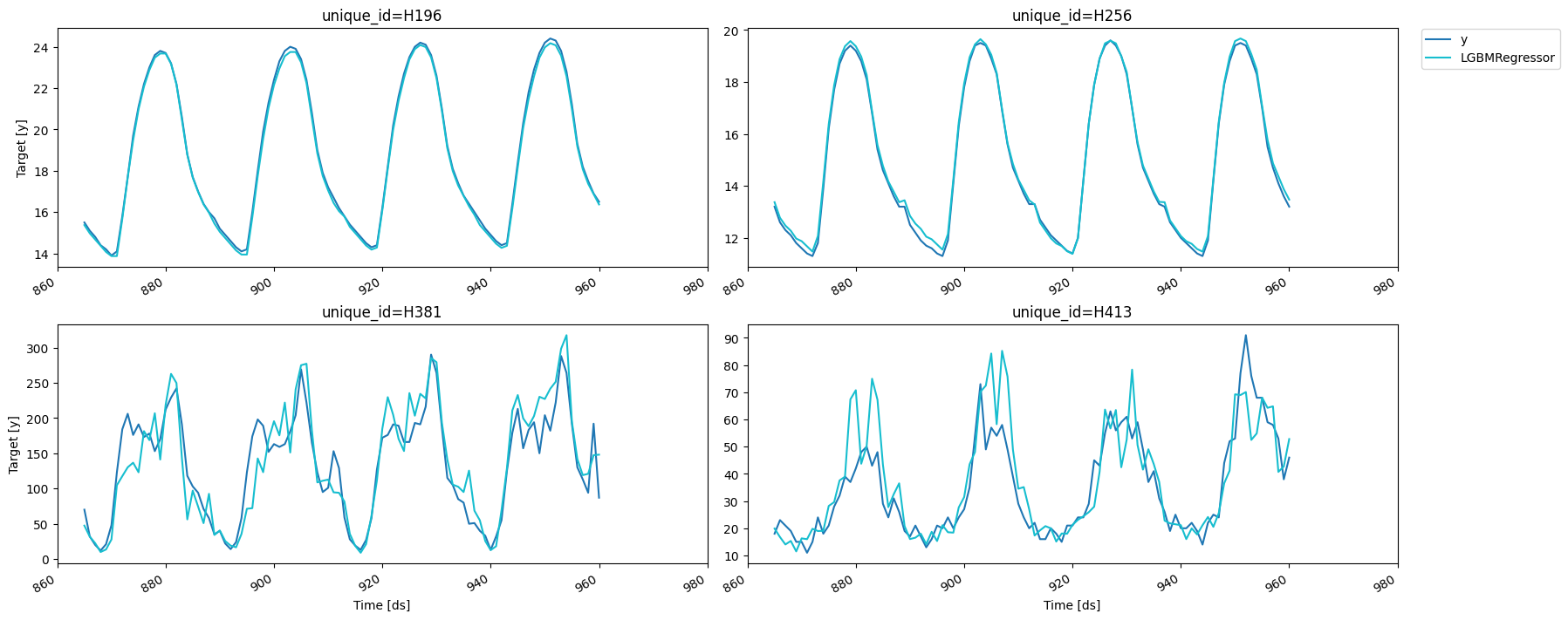
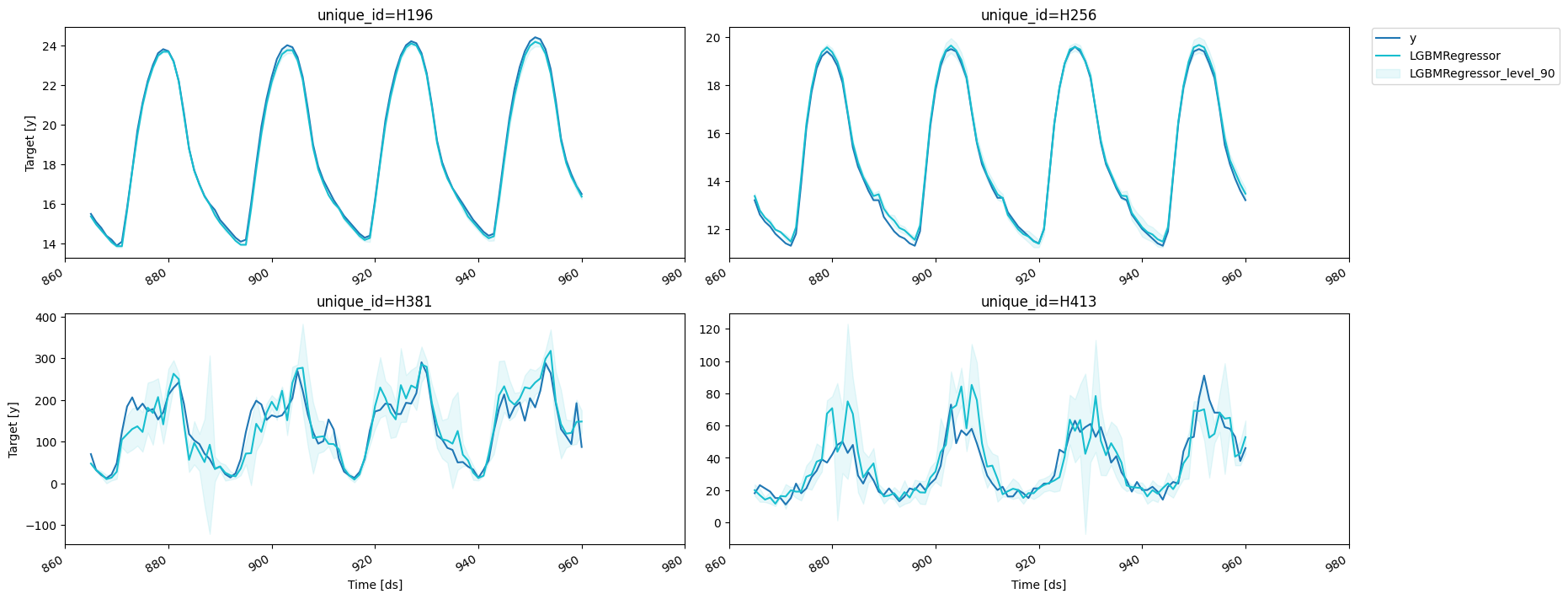
source
MLForecast.from_cv
Once you’ve found a set of features and parameters that work for your problem you can build a forecast object from it using
MLForecast.from_cv,
which takes the trained
LightGBMCV
object and builds an
MLForecast
object that will use the same features and parameters. Then you can call
fit and predict as you normally would.

